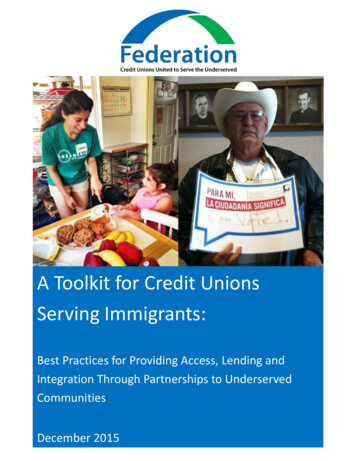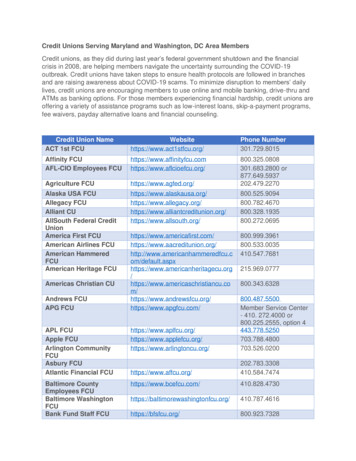
Transcription
A Toolkit for Credit UnionsServing Immigrants:Best Practices for Providing Access, Lending andIntegration Through Partnerships to UnderservedCommunitiesDecember 2015
TABLE OF CONTENTSExecutive Summary 1Background 2I. Access 3A. Removing Barriers: Establishing an Inclusive CIP Program 3Alternative IDs 3B. Removing the Perception of Barriers: Marketing and Outreach to Diverse Populations 6II. Products 7Loan Characteristics 8Targeted Loans 81. Citizenship/Deferred Action on Childhood Arrivals (DACA) Loans 9Pathways to Scale Equity 102. Emergency Loans: Borrow & Save 123. Credit Builder Loans 124. ITIN Mortgages 13III. Partnerships 14Conclusion and Next Steps 16Case Study: Northwest Area Immigrant Asset-Building Initiative Results 17Appendices 21Appendix i: Samples of Acceptable Alternative IDs for Account Opening 21Appendix ii: Marketing Materials and Immigrant Programs at CDCUs 22Appendix iii: Sample Loan Policy 26Appendix iv: Examples of leveraged CDCU partnerships expanding to other opportunities 27Appendix v: Arleny’s Story – Experience of an Immigrant Who Benefitted from DACA andDreamer Loan from a Credit Union 29
EXECUTIVE SUMMARYImmigrants play a major role in the US economy. In 1960, 1 in 20 immigrants in the US was from Europe.Today, immigrants are younger, come predominately from Latin American and Asia and make up 1 out of 8of the US population 1.The benefits of a younger, working immigrant population are innumerable. But despite their economiccontributions, many low-income immigrants are often excluded from critical services, including financialaccess 2. The credit union movement has historically had a mission of serving immigrants, and CommunityDevelopment Credit Unions (CDCUs), stalwarts of economic justice, are poised to lead the effort to guideimmigrants to a path of financial independence based on their history of serving low-income communities.The National Federation of Community Development Credit Unions (Federation) has learned much abouthow best to serve immigrants during its 41-year history of serving underserved consumers. This toolkit isa culmination of a multi-year partnership between the Federation and Grantmakers Concerned withImmigrants and Refugees (GCIR), drawing on the lessons learned from the Northwest Area ImmigrantAsset-Building Initiative (NAIABI), a pilot program aimed to increase financial access to immigrants.Special thanks to the Northwest Area Foundation for their generous support for this initiative and theirleadership in connecting immigrant communities to asset building opportunities. This toolkit focuses onaccess, appropriate lending products, and partnerships, the pillars for a successful program. The toolkitprovides a case study of how credit unions, through successful partnerships, have reached local immigrantcommunities to provide access to high-quality service while growing their business.Findings from the Northwest Area Immigrant Asset-Building Initiative include: By providing financial access through ITINs and alternative IDs, credit unions can build trustamong immigrants for financial institutions and counter a perception that immigrants might beunwelcome or unable to access mainstream banking services;By implementing critical financing programs in an affordable, transparent and convenient fashion,credit unions can gain new, loyal members;In partnering with reputable nonprofit organizations that serve immigrants, credit unions canestablish a referral channel that can be leveraged to form additional partnerships with otherstakeholders including government entities and businesses at scale.United States Census Bureau, “The Size, Place of Birth, and Geographic Distribution of theForeign-Born Population in the United States: 1960 to iles/WorkingPaper96.pdf1Voices of NY, “Financial Access Hard to Get for Immigrants,” -get-immigrants/2Page 1
BACKGROUNDImmigrants are a vibrant and dynamic part of the nation's social and economic fabric. In fact, more than 40percent of Fortune 500 companies were founded by first-generation immigrants or their children 3.America’s foreign-born population has gone through drastic changes since the 1960s. Today, some 40million foreign-born immigrants call the US their home, representing 13% of the total U.S. population,compared to 9.7 million in 1960 4.The issue of immigration has come to the forefront of policy circles. Without a clear path to naturalization,an estimated 11.3 million undocumented immigrants remain “in the shadows” out of fears that they will bedeported 5. Low-income immigrants represent a large part of the 10 million total US households that theFDIC estimates are currently unbanked (possessing no checking or saving account), compounding the needfor bold action to promote financial inclusion. More than 40 percent of low-income Hispanics areunderbanked, with 18.9% of foreign-born-non-citizen households unbanked, and a further 28.6%underbanked (heavily reliant on high-cost fringe providers). 6As larger policy questions continue to cycle through the national debate, Community Development CreditUnions (CDCUs) have the opportunity to help immigrants integrate into the financial mainstream. Creditunions have a history of serving immigrants, starting with the St. Mary’s Bank Credit Union that wasformed in New Hampshire in 1908 to serve French-speaking immigrants from Canada. For immigrantsunable to join mainstream banks because of their immigration status, CDCUs today are well-positioned toserve them and continue their historic mission.A key question is how best to connect immigrant communities to safe, reliable and affordable financialproducts and services. As immigrant populations remain on the sidelines of the US financial system,opportunities for building assets of individuals, families and communities are missed.This toolkit, intended for credit unions looking to serve immigrants, focuses on three pillars: access,appropriate lending products, and partnerships with immigrant-serving nonprofits, businesses,government agencies and others.3Partnership for New American Economy, ship/Immigration Policy Center, “Strength in Diversity: the Economic and Political Clout of Immigrants, Latinos,and Asians in the United efault/files/docs/usa 2013 0.pdf4Pew Research Center, “5 Facts About Illegal Immigration in the US,” acts-about-illegal-immigration-in-the-u-s/5Federal Deposit Insurance Corporation, “2011 FDIC National Survey of Unbanked and UnderbankedHouseholds,” http://www.fdic.gov/householdsurvey/2012 unbankedreport.pdf6Page 2
ACCESSThe most basic aspect of financial inclusion for immigrants starts with access to high-quality financialservices. With multiple immigration categories available and many immigrant families themselves in mixedstatuses, it is crucial that credit unions have as much clarity as possible on immigrant membershipeligibility before launching marketing and outreach efforts to immigrants. This section provides anoverview of the Customer Identification Program (CIP), as well as alternative IDs that can be accepted bycredit unions.A. REMOVING BARRIERS: ESTABLISHING AN INCLUSIVE CIP PROGRAMThe federal regulator for credit unions, the National Credit Union Administration (NCUA), issued guidanceon CIP requirements for credit unions that are in line with other banking regulations and mandates thatevery credit union must obtain the full name, date of birth, address of residence or business, and taxpayeridentification number (TIN) of any individual residing in the US in order to open an account (Letter 030964, 2003). It further stipulates that if the individual is a resident of another country, a passport numberor alien identification card number can be used in place of the TIN to open accounts. However, only a TINcan be accepted for interest-bearing accounts and this information must be accompanied by a governmentissued photo ID that establishes nationality and/or residence.The three types of taxpayer identification numbers that are approved by the NCUA to open an accountinclude: Social Security number (SSN): SSNs are generally given to US citizens and resident aliensthat are legally eligible for residency and employment in the US;Individual Taxpayer Identification Number (ITIN): Individuals that cannot obtain a SSNcan apply for an ITIN through the Internal Revenue Service (IRS). ITINs are issued by the IRSand enable immigrants to report earnings and file income taxes. While ITINs allow immigrantsto file taxes, it should be noted that receiving an ITIN number does not represent anauthorization to work in the US or access social security benefits;Employer Identification Number (EIN) for businesses: EINs are the corporate equivalent ofITINs, typically issued to businesses that file withholding taxes on employees.ALTERNATIVE IDSOther acceptable IDs for account opening purposes include consular IDs such as the Matricula Consular,Documento Personal de Identificacı́on (DPI), Voter’s ID and where available, municipal IDs. Following thelegal opinion letter (03-0964) issued by the NCUA, these IDs are legal forms of IDs that can be accepted atcredit unions. The Federation played a key role in advocating for the acceptance of Municipal IDs at NewPage 3
ACCESSYork City credit unions and today 8 credit unions accept Municipal IDs for account opening purposes. Whileit is not mandated that credit unions accept them, it is crucial that credit unions looking to serveimmigrants accept alternative IDs as part of their account opening procedures. In 2004, NCUA boardchairman Debbie Matz stated "if you really want to make headway in the Hispanic community, you reallyneed to accept alternative IDs 7”. Please see appendix i for samples of alternative IDs.While regulations surrounding acceptable forms of identification for immigrants seem complex, theoverview of acceptable forms of identification illustrate that in fact, financial access to credit unions ispossible for immigrants, including those that are undocumented. Credit unions should nonetheless consultwith their compliance team and the NCUA before embarking on programs that serves immigrants.Account OpeningAcceptable alternate forms of IDs: Passports Matricula Consular Documento Personal deIdentificacíon (DPI) Voter IDs Municipal IDsTaxpayer IDs for interest-bearing accounts: SSN EIN ITINsA sample of CIP-compliant account opening policy used by credit unions to establish member accounts forimmigrants is included below.Credit Union Times, “Matricula Consular Acceptable for la-consular-acceptable-for-loans7Page 4
ACCESSSample of CIP-compliant Account Opening PolicyVerification of Identity: NameDate of birthPhysical address at which the person resides and mailing address if differentAn unexpired, government issued photo ID For US persons, a taxpayer identification number such as social security number, individualtaxpayer identification number or employer identification number for business accounts. For non-US persons, one or more of the following: a US taxpayer identification number,passport number and country of issuance; alien identification card number; or number andcountry of issuance of any other government-issued document evidencing nationality orresidence and bearing a photograph or similar safeguard.Verification Requirements: In order to verify the identity of the applicant, at least one document provided should be anunexpired government issued photo identification card (driver’s license or military ID). Anyother documentation gathered from the applicant to verify the required information isflexible and can include social security cards, certified birth certificates, utility bills, phonebills, pay stubs, etc.Some applicants will not have an unexpired government issued photo ID card. In those instances: The applicant may provide another form of ID in conjunction with a government issueddocument showing the member’s social security number or tax identification number. If theapplicant is a non-U.S. person, passports, immigration documents, unexpired employmentauthorization documents are acceptable. If the applicant does not have any form of photo ID, he/she may present two forms ofidentification. One must be government issued (social security card, passport, immigrationdocuments, etc).If the applicant cannot provide the information required, the account will not be opened.Page 5
ACCESSB. REMOVING THE PERCEPTION OF BARRIERS: MARKETING AND OUTREACH TO DIVERSEPOPULATIONSMarketing in the immigrant’s language, through trusted avenues, is critical to a credit union’s success inserving and growing membership among immigrants. The most successful credit unions that serveimmigrants have multiple channels of interaction and relationships with the community. The ability to dobusiness in languages spoken among immigrant communities is clearly essential, but taking the extra stepto provide bilingual or multilingual signage and materials sends a clear signal to potential members thatthey are welcome at credit unions.Many credit union staff members participate in informational events to talk about personal finance. Theseconnections are useful to spread the word about the credit union’s outreach to immigrants. The ability toshare financial information with local ethnic media is a win-win, providing reliable content to theiraudiences while making sure the credit union is known among immigrant communities.Page 6
PRODUCTSBy accepting alternative IDs and ITINs, financial access can become a reality for many immigrants.Immigrants can build savings, transact more affordably, access small dollar loans, signature/personal loans,auto loans, credit builders, and ultimately business loans and mortgages. Savings products such as interestbearing savings accounts, Individual Development Accounts (IDAs) or longer-term investments such asShare Certificates, can help build assets over time.Key challenges that low-income immigrants face in managing their financial lives include: Credit history: immigrants may have non-traditional credit histories or no history;Job instability: immigrants, particularly undocumented immigrants, can encounter jobinstability due to lack of legal work status;Spending/saving: immigrants may have diverse sources of income and saving/spendingpatterns;Remittances: immigrants may send a significant portion of their earnings to family out of thecountry via remittances;Debt from restricted services: in select cases, immigrants may have incurred debt fromservices that are typically restricted to them (i.e. medical bills for those without medicalinsurance).There is no one-size-fits-all solution to working with immigrant communities. Each credit union must do itsown research in their local market to better understanding the opportunities and barriers faced in thecommunities they wish to serve. It is also important to realize that barriers may reflect untapped demandrather than challenges. One example is in ITIN lending where credit unions target specific loan products tothose who have individual taxpayer ID numbers. The experience of ITIN mortgage lending programssuggests that immigrant lending performs no worse than traditional loans 8. We will discuss why it isbeneficial for credit unions to integrate immigrants with limited experience or no experience working withfinancial institutions in the coming sections, including how this may help the credit union's bottom line.Recommendations drawn from case studies around the country and the Northwest Area Immigrant AssetBuilding Initiative illustrate how profitably serving immigrants can be achieved.National Mortgage News, “Setting the Record Straight on Mortgages for Undocumented 07-1.html8Page 7
PRODUCTSLOAN CHARACTERISTICSImmigrants often have a skeptical view of financial institutions 9. Addressing what immigrants look for in afinancial institution is critical to the success of outreach and to alleviate concerns. Some of the elements toconsider when lending to immigrants include:1.2.3.4.5.Affordability: pricing, while reflecting accurate costs and risks, should be consistent with the restof your product line up;Transparency: account opening and loan policy procedures must be transparent to avoidmisinformation and is critical to gain the trust of target market;Simplicity/convenience: products and processes must be simple, easy to understand and use;they should also be accessible through use of online banking, community partnerships andmicro/school branches;Service to all: people, regardless of their immigration status, want to be treated equally withrespect and dignity;Path to prosperity: products should provide a pathway to financial inclusion regardless of theborrower’s income or status.As immigrants are generally more likely to face adverse conditions when trying to access credit, the aboveelements, especially affordability, are critical to differentiate CDCUs and alleviate concerns of trust. CDCUsare drivers of community development and their products and services should reflect this mission.TARGETED LOANSSome may worry that integrating immigrants into a credit union’s membership may mean redesigningproducts and services, but this is not necessarily the case. Credit unions already have products and servicesthat are suitable for immigrants. A few tweaks to existing products can go a long way to provide theproducts that immigrants are seeking. For credit unions looking to build experience in serving immigrants,offering small dollar loans may be an ideal entry point that can lead to deeper engagements in the future.Small dollar loans can be especially important to immigrants looking to change their immigration statuswhich can be costly for families. For those that do wish to establish products tailored to immigrants andnew Americans, below are some examples:Rincó n & Associates, “Qualitative Study of the Banking Experiences of Latino Immigrants in tudy2004.pdf9Page 8
PRODUCTS1. CITIZENSHIP/DEFERRED ACTION ON CHILDHOOD ARRIVALS (DACA) LOANSCitizenship can enable immigrants to vote and access all the programs and services that are available toAmericans. Citizenship can also boost the immigrant’s earning power and the nation’s GDP 10. Thecitizenship application cost of 680 per applicant, however, can pose a barrier for many families: for afamily of three living at 2015 federal poverty levels, application costs can be equivalent of more than 10%of a family’s annual income 11.With the Executive Order signed by President Obama, Deferred Action on Childhood Arrivals (DACA)became law in 2012. The policy allows some undocumented immigrants who entered the country beforetheir 16th birthday and before June 2007 to receive a work permit and exemption from deportation. Toapply for DACA, applicants must submit documents indicating eligibility along with a 465 application feethat is subject to renewal every two years. DACA can make a big difference for immigrants previouslyunable to obtain legal work, and in some states, can provide access to additional benefits such as eligibilityfor in-state tuition at universities.Many immigrants also need help from legal service providers to complete their applications, adding to thetotal cost. For this reason, the credit union should take legal costs into account when exploring loanparameters for citizenship and DACA. While credit unions should structure these small-dollar loans in theway that makes most sense to them, the Federation recommends the following guidelines for immigrantsmall-dollar lending to help offset the costs of citizenship or DACA applications.Small-dollar loan guidelines for immigrantsAmount Range:Term:Rate:Application Fee:Eligibility and Underwriting: 500 - 1,00012 months12.5% - 15% APR 20Available to all qualifying for membership; rapidturnaround and notification; no credit checks; flexibleincome verification; minimal financial checkup; norollovers.White House, “The Economic Benefits of Providing a Path to Earned tizenship10US Department of Health and Human Services 2015 Poverty Guidelines, ines11Page 9
PRODUCTSAs seen above, the small dollar loan guidelines for immigrants will not likely deviate much from the currentloan terms offered by credit unions. However, as immigrants may lack credit history, a credit union maywant to pull credit for information and evaluation purposes only. For this reason, and to achieve economiesof scale, the Federation recommends a rate range of 12.5% to 15% to mitigate risk while allowing formaximum flexibility in underwriting.Below are some examples of citizenship loans and DACA loans offered by CDCUs:CitizenshipDACATerm: up to 24 MonthsTerm: up to 12 monthsAmount: up to 1,500 per member seekingindividual naturalization assistance and upto 3,000 per familyFee: 25 loan origination fee per loanRate: As low as 9.99% APRRequired documents:1. Proof of state residency2. Identification, including alternative IDs3. Proof of citizenship application ready tobe submittedAmount: 470Rate: 15% APRRequired documents:1. Proof of state residency2. Identification, including alternative IDs3. Proof of income (Paystub, tax return, W2,etc.)4. Contact information for 2 referencesPATHWAYS TO SCALE EQUITYTo determine scalability for a small dollar loan, we put the small dollar loan guidelines mentioned above tothe test. To understand the scale required for a positive return on investment (ROI), we make certainassumptions about the cost of the loan product, as well as the costs associated with administering theprogram and loan terms based on previous research. We have found that many credit unions are using 15%APR for their immigrant citizenship loans. On the loan revenue side, we tested for scalability for a 12month, 750 amortizing small-dollar loan with a 20 application fee.Page 10
PRODUCTSRevenue:Costs:Loan CapitalInterest RateApplication FeeLoan ProcessingOther Associated Costs (i.e. Marketing,collections)OverheadsDefaultsCost of FundsUsing the assumptions noted above, a volume of between 125-150 loans is typically required to break even.Each credit union will need to establish their own pricing and underwriting, but this is a recommendedrange based on Federation members’ experience. Our goal is to provide credit unions a sense of thepipeline and volume they should establish as a benchmark. Forging partnerships with immigrant-servingnonprofits that have a sufficient volume of clients seeking financing can boost the credit union’s ability toachieve economies of scale.The graph below illustrates the ROI rate for loans ranging from 100 to 1,200 in volume:Scalability of 750 Small-Dollar Loans6.0%5.0%4.0%3.0%3.0%3.6%4.6% 4.6% 4.7%4.3% 4.4% 4.5%4.1%3.9%1.9%2.0%1.0%0.0%-1.0%100 200 300 400 500 600 700 800 900 1000 1100 1200Return onInvestmentLog. (ReturnonInvestment)-2.0% -1.4%The graph shows that small-dollar loans can be scalable, especially if paired with clients from trustworthysources of referrals. For an illustration of partnerships on the ground and pilot results, please see CaseStudy: Northwest Area Immigrant Asset-Building Initiative Results on page 18.Page 11
PRODUCTS2. EMERGENCY LOANS: BORROW & SAVE For credit unions seeking to further mitigate risk, another approach that may be appropriate for servingimmigrants includes a small dollar loan with a built-in savings component. Borrow and Save , theFederation’s small dollar loan program with a dedicated savings component, reduces risk to credit unionswhile offering an opportunity to build assets for borrowers. A dedicated savings can offer even strongerincentives for immigrant borrowers to repay, forge links with credit unions and take up opportunities forasset-building. Through a pilot with the Filene Research Institute sponsored by the Ford Foundation, theBorrow and Save program has deployed more than 3100 loans between May 2014 – July 2015 that haveresulted in more than a 1MM in savings for members. The following chart outlines the guidelines for ascalable Borrow & Save loan product:Small-dollar Loan Structure for Borrow & Save Amount range:Loan Term:Interest Rate:Application Fee:Accumulated SavingsEligibility and Underwriting: 300 - 1,0003-12 monthsNo more than 28% APR 2025% - 50% of principal (frozen until loan fully paidoff):ID and proof of income or rent and utility paymentswith current address required; credit check (soft pull);one loan out at a time, no more than 3 rollovers peryear3. CREDIT BUILDER LOANSCredit builder loans may be another way to engage immigrants, particularly new immigrants, that have notyet established a credit score in the US or for immigrants with damaged credit. A credit builder loan istypically secured by establishing savings that the consumer can borrow against to access a lump sum whichbecomes available immediately. The loan proceeds can be used for filing immigration status applications orother needs while building credit as the loan is paid back. The dual effects of accessing a loan whilebuilding credit can be positive for low-income immigrants and can provide a path for accessing other largerloan products in the future.Page 12
PRODUCTS4. ITIN MORTGAGESHomeownership is a critical pathway for building assets. For immigrants, the lack of home ownership canbe a source of instability and insecurity. Immigrants with a SSN qualify for traditional mortgages, butimmigrants without a SSN must use an ITIN to access mortgages. While there is a market for ITINmortgages, it remains a niche market product due to misinformation and a lack of understanding in thisarea. ITIN mortgages also tend to be more expensive than traditional mortgages because there is nosecondary market for it. To alleviate these concerns, the Federation’s Mortgage Center is committed tohelping credit unions offer ITIN mortgages along with their other home mortgage product offerings. TheMortgage Center will purchase qualifying ITIN mortgages at origination from member CDCUs usingcommonly used underwriting and centralized servicing at fair rates to serve a virtually untouched market.For more information, please visit: s-for-creditunions/cdcu-mortgage-center/.Page 13
PARTNERSHIPSFor credit unions getting started with immigrant financial inclusion, partnering with an established,reputable nonprofit organization is crucial and will likely be the main source of immigrant referrals.Nonprofits can act as a liaison between the credit union and the immigrant client. Well-establishedpartnerships require a degree of planning to learn about each other’s work, identifying the specialties eachpartner brings to the table. These partnerships also require coordination to ensure that the referralchannel operates smoothly.The Federation’s study Pathways to Financial Capability - Diagnostic Frameworks for Financial Institutionsand Partners 12 provides five key ingredients for a successful partnership: Convergent vision: identifying a common goal that furthers each partner’s respective missionComplementary capacities: bringing capacity that the potential partner desires but cannot obtainon its ownCommitment: ability to improvise on the fly as needed, applying lessons learned quickly, withcontinuous tweaking to get it rightCoordination: accountable to each other and frequent check-ins, keeping up to date in all aspectsof the partnershipConfidence: competence and trust in each other to complete the scope of partnershipNational Federation of Community Development Credit Unions and Center for Financial ServicesInnovation, “Pathways to Financial Capability: Diagnostic Frameworks for Financial Institutions andPartners,” pability/12Page 14
PARTNERSHIPSAn example of a partnership flow and refinementIn the NAIABI pilot, both partners saw that eff
overview of the Customer Identification Program (CIP), as well as alternative IDs that can be accepted by credit unions. A. REMOVING BARRIERS: ESTABLISHING AN INCLUSIVE CIP PROGRAM . The federal regulator for credit unions, the National Credit Union Administration (NCUA), issued guidance










